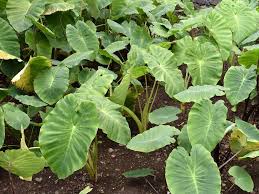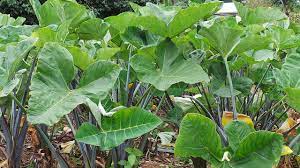Cocoyam (Xanthosoma spp. and Colocasia spp.) is a root vegetable native to tropical regions and is known for its starchy tubers. The term “stolon buds” refers to the buds or shoots that grow along the stolons of the cocoyam plant.
Stolons are horizontal stems that grow along the surface of the soil, producing nodes from which new plants or shoots can sprout. In the case of cocoyam, stolon buds are small, emerging shoots or nodes that develop along the stolons. These buds can give rise to new plants or can be used for propagating cocoyam. Choose healthy, disease-free cocoyam plants with well-developed stolons.
Look for small buds or shoots along the stolons. These buds are potential sites for new growth. Gently separate the buds or shoots from the stolons. Ensure that each bud has some roots or a portion of the stolon attached. Prepare a well-draining soil bed with adequate organic matter and nutrients for planting the stolon buds.
Plant the stolon buds in the prepared soil at a suitable depth, ensuring that the bud and roots are adequately covered. Proper care, including regular watering, adequate sunlight, and appropriate fertilization, to encourage healthy growth and development of the new plants.
By using stolon buds for propagation, you can create new cocoyam plants and expand your cocoyam garden or crop.
The Economic Importance and Uses of Cocoyam Stolon buds

Cocoyam, also known as taro, is a tuberous root vegetable widely cultivated in tropical and subtropical regions. Cocoyam stolon buds refer to the small shoots or buds that grow on the stolon (an underground stem) of the cocoyam plant.
These stolon buds have several economic importance and uses, including:
1. Food source: Cocoyam stolon buds are a valuable source of nutrition and are consumed as a staple food in many parts of the world. They are rich in carbohydrates, dietary fiber, vitamins, and minerals, making them an important part of the diet for many communities.
2. Income generation: Cultivation and sale of cocoyam stolon buds contribute to the income generation of farmers and local communities. As a marketable crop, cocoyam stolon buds provide a source of livelihood for farmers and traders involved in its production and distribution.
3. Food security: Cocoyam stolon buds help enhance food security by providing a reliable and accessible food source. They can be harvested and consumed throughout the year, providing sustenance and nutrition, especially in areas where other crops may be less available.
4. Culinary versatility: Cocoyam stolon buds can be prepared in various culinary dishes, adding diversity to diets. They can be boiled, steamed, fried, roasted, or incorporated into soups, stews, and other traditional dishes. The versatility in cooking methods allows for a wide range of culinary applications.
5. Medicinal uses: In some cultures, cocoyam stolon buds are believed to have medicinal properties. They are used in traditional medicine to treat ailments such as digestive issues, skin conditions, and respiratory problems. However, it’s important to note that scientific evidence regarding their medicinal efficacy may vary.
6. Soil conservation and erosion control: The cocoyam plant, including its stolon buds, plays a role in soil conservation. Its extensive root system helps prevent soil erosion, making it a valuable crop in areas prone to soil degradation.
7. Crop rotation and sustainability: Cocoyam cultivation, including stolon buds, can be part of a crop rotation strategy. It helps maintain soil fertility and reduces pest and disease pressures on other crops, contributing to sustainable agricultural practices.
8. Livestock feed: Cocoyam stolon buds can be used as fodder for livestock, providing an additional source of nutrition for animals. This helps in supplementing their diet and supporting livestock health and productivity.
9. Cultural and traditional uses: Cocoyam stolon buds are deeply ingrained in the culinary traditions and cultural practices of many communities. They are often featured in special dishes during celebrations, festivals, and traditional gatherings, showcasing their cultural significance.
Read Also: Cocoyam stems: Economic Importance, Uses, and By-Products
10. Industrial uses: Cocoyam stolon buds can also have industrial applications, such as in the production of starch and flour. The extracted starch can be used in food processing and manufacturing various products, adding to its economic value.
The Products and By-products That Can Be Derived From Cocoyam Stolon buds
Cocoyam, also known as taro or yam tuber, is a starchy root vegetable widely grown and consumed in various parts of the world. The stolon buds of cocoyam are a crucial part of the plant and can be used to derive several products and by-products.
Here’s a list and explanation of potential products and by-products:
1. Cocoyam Flour: The stolon buds can be dried and ground into a fine flour, which can be used as a base for various food products, including bread, cakes, pastries, and other baked goods.
2. Cocoyam Chips: Stolon buds can be sliced thinly and fried to make chips or crisps, which are a popular snack in many cultures.
3. Cocoyam Fritters: The stolon buds can be mixed with a batter and deep-fried to make fritters, a tasty and popular snack.
4. Cocoyam Porridge: The stolon buds can be cooked and mashed to make a creamy and nutritious porridge, often consumed as a breakfast or main meal in some cultures.
5. Cocoyam Soup or Stew: Stolon buds can be used as an ingredient in soups or stews, providing a unique flavor and enhancing the nutritional content of the dish.
6. Cocoyam Chips (Animal Feed): Stolon buds that are not suitable for human consumption or are surplus can be dried and processed into animal feed, providing a source of nutrition for livestock.
7. Cocoyam Peelings (Organic Fertilizer): The peelings and waste from processing cocoyam can be composted or used as organic fertilizer to improve soil fertility and enhance crop growth.
8. Cocoyam Vine Cuttings (Propagation): Stolon buds can be used as cuttings for propagating new cocoyam plants, allowing for the expansion of cocoyam cultivation.
9. Cocoyam Snacks (Value-added Products): Stolon buds can be used as a base for developing various value-added snack products, such as flavored chips or baked snacks.
10. Cocoyam Beverage: Stolon buds can be processed to create a beverage, similar to a smoothie or juice, which can be consumed for its nutritional benefits and pleasant taste.
11. Cocoyam Pulp (Pectin Extraction): The stolon buds’ pulp can be used for extracting pectin, a substance commonly used in food preservation, particularly in jams and jellies.
In conclusion, cocoyam stolon buds are a versatile and important agricultural product with multiple economic uses, ranging from food consumption to income generation, medicinal applications, and soil conservation. Their cultivation and utilization contribute to food security, sustainable agriculture, and the overall well-being of communities.
Read Also: What Are the Benefits of Growing Jasmine Flowers?

